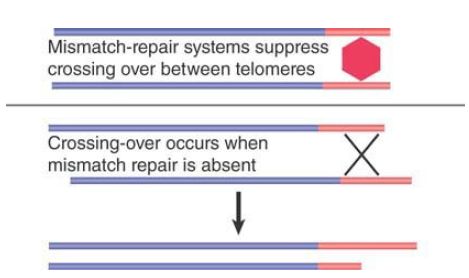


 النبات
النبات
 الحيوان
الحيوان
 الأحياء المجهرية
الأحياء المجهرية
 علم الأمراض
علم الأمراض
 التقانة الإحيائية
التقانة الإحيائية
 التقنية الحيوية المكروبية
التقنية الحيوية المكروبية
 التقنية الحياتية النانوية
التقنية الحياتية النانوية
 علم الأجنة
علم الأجنة
 الأحياء الجزيئي
الأحياء الجزيئي
 علم وظائف الأعضاء
علم وظائف الأعضاء
 الغدد
الغدد
 المضادات الحيوية
المضادات الحيوية|
Read More
Date: 4-6-2021
Date: 31-10-2020
Date: 22-4-2021
|
Telomeres Are Essential for Survival
KEY CONCEPTS
-Telomerase is expressed in actively dividing cells and is not expressed in quiescent cells.
-Loss of telomeres results in senescence.
-Escape from senescence can occur if telomerase is reactivated, or via unequal homologous recombination to restore telomeres.
Telomerase activity is found in most dividing cells (such as embryonic cells, stem cells, and in unicellular eukaryotes) and is generally turned off in terminally differentiated cells that do not divide. FIGURE 1 shows that if telomerase is mutated in a dividing cell, the telomeres become gradually shorter with each cell division.

FIGURE 1 Mutation in telomerase causes telomeres to shorten in each cell division. Eventual loss of the telomere causes chromosome breaks and rearrangements.
Loss of telomeres has dire effects. When the telomere length reaches zero, it becomes difficult for the cells to divide successfully. Attempts to divide typically generate chromosome breaks and translocations. This causes an increased rate of mutation. In yeast, this is associated with a loss of viability, and the culture becomes predominantly occupied by senescent cells (which are elongated and nondividing, and eventually die).
Some cells grow out of the senescing yeast culture. They have acquired the ability to extend their telomeres by an alternative to telomerase activity. The survivors fall into two groups. The
members of one group have circularized their chromosomes: They now have no telomeres, and as a result they have become independent of telomerase. The other group uses unequal crossing-over to extend their telomeres (see FIGURE 2). The telomere is a repeating structure, so it is possible for two telomeres to misalign when chromosomes pair. Recombination between the mispaired regions generates an unequal crossing-over (as discussed in the chapter Clusters and Repeats): When the length of one recombinant chromosome increases, the length of the other decreases.

FIGURE 2 Crossing-over in telomeric regions is usually suppressed by mismatch-repair systems, but can occur when they are mutated. An unequal crossing-over event extends the telomere of one of the products, allowing the chromosome to survive in the absence of telomerase.
Cells usually suppress unequal crossing-over because of its potentially deleterious consequences. Two systems are responsible for suppressing crossing-over between telomeres. One is provided by telomere-binding proteins. In yeast, the frequency of recombination between telomeres is increased by deletion of the gene TAZ1, which codes for a protein that regulates telomerase activity. The second is a general system that is responsible for mismatch repair. In addition to correcting mismatched base pairs that can arise in DNA, this system suppresses recombination between mispaired regions. Figure 2 shows that this includes telomeres. When it is mutated, a greater proportion of telomerasedeficient yeast survives the loss of telomeres because recombination between telomeres generates some chromosomes with longer telomeres.
When eukaryotic cells from multicellular eukaryotes are placed in culture, they usually divide for a fixed number of generations and then enter senescence. The reason appears to be a decline in telomere length because of the absence of telomerase expression.
Cells enter a crisis from which some emerge, but typically the cells that emerge have chromosome rearrangements that have resulted from lack of protection of chromosome ends. These rearrangements can cause mutations that contribute to the tumorigenic state. The absence of telomerase expression in this situation is due to failure to express the gene (a normal condition of differentiated cells), and reactivation of telomerase is one of the mechanisms by which these cells then survive continued culture. The vast majority of cancer cells reactivate telomerase, though a small percentage also utilizes unequal recombination to maintain telomeres during prolonged proliferation.
It has long been suggested that within a species, greater telomere length could lead to greater cellular lifespans in tissues and thus to increased lifespan of the organism. Although data to support this has been generally lacking, recent work in zebra finches has shown that telomere length measured very early in life can in fact predict lifespan. It is not yet clear whether these results will apply to other species, including humans, but this work is the first clear evidence
that telomere length can in fact correlate with natural aging and lifespan.



|
|
|
|
إجراء أول اختبار لدواء "ثوري" يتصدى لعدة أنواع من السرطان
|
|
|
|
|
|
|
دراسة تكشف "سببا غريبا" يعيق نمو الطيور
|
|
|
|
|
|
بالفيديوغراف: ممثل المرجعية الدينية العليا والامين العام للعتبة الحسينية يتفقدان مشروع مطار كربلاء الدولي
|
|
|
|
بالصور: سنابل تفيض بالخير في مزارع العتبة الحسينية (عمليات حصاد الحنطة)
|
|
|
|
تضمنت الجولة توجيهات متعلقة براحة المسافرين.. ممثل المرجعية العليا والامين العام للعتبة الحسينية يطلعان ميدانيا على سير العمل في مطار كربلاء الدولي
|
|
|
|
بالفيديو: مركز لعلاج العقم تابع للعتبة الحسينية يعلن عن أجراء (117) عملية تلقيح اصطناعي خلال الربع الاول من العام الحالي
|